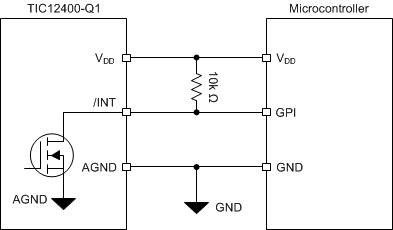ZHCSGP5C August 2017 – February 2022 TIC12400-Q1
PRODUCTION DATA
- 1 特性
- 2 应用
- 3 说明
- 4 Revision History
- 5 Pin Configuration and Functions
- 6 Specifications
- 7 Parameter Measurement Information
-
8 Detailed Description
- 8.1 Overview
- 8.2 Functional Block Diagram
- 8.3
Feature Description
- 8.3.1 VS Pin
- 8.3.2 VDD Pin
- 8.3.3 Device Initialization
- 8.3.4 Device Trigger
- 8.3.5 Device Reset
- 8.3.6 VS Under-Voltage (UV) Condition
- 8.3.7 VS Over-Voltage (OV) Condition
- 8.3.8 Switch Inputs Settings
- 8.3.9 Interrupt Generation and INT Assertion
- 8.3.10 Temperature Monitor
- 8.3.11 Parity Check and Parity Generation
- 8.3.12 Cyclic Redundancy Check (CRC)
- 8.4 Device Functional Modes
- 8.5 Programming
- 8.6 Register Maps
- 8.7 Programming Guidelines
- 9 Application Information Disclaimer
- 10Power Supply Recommendations
- 11Layout
- 12Device and Documentation Support
- 13Mechanical, Packaging, and Orderable Information
8.3.9 Interrupt Generation and INT Assertion
The INT pin is an active-low, open-drain output that asserts low when an event such as switch input state change, temperature warning, over-voltage shutdown, and so fourth, is detected by the TIC12400-Q1. An external pull-up resistor to VDD is needed on the INT pin (see Figure 8-4). The INT pin can also be connected directly to a 12 V automotive battery to support the microcontroller wake-up feature, as describe in Section 8.3.9.3.
 Figure 8-4 INT Connection Example #1
Figure 8-4 INT Connection Example #1